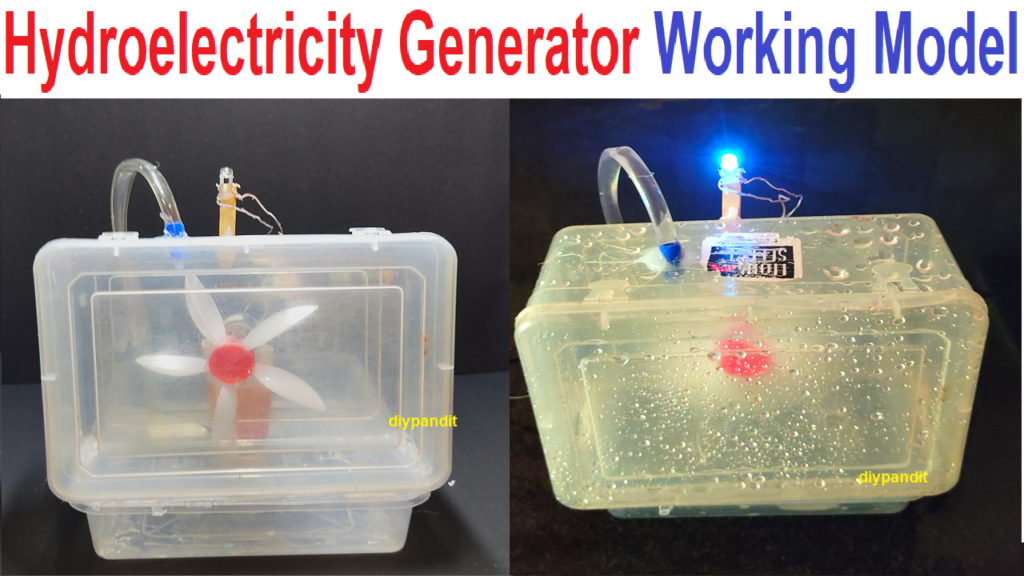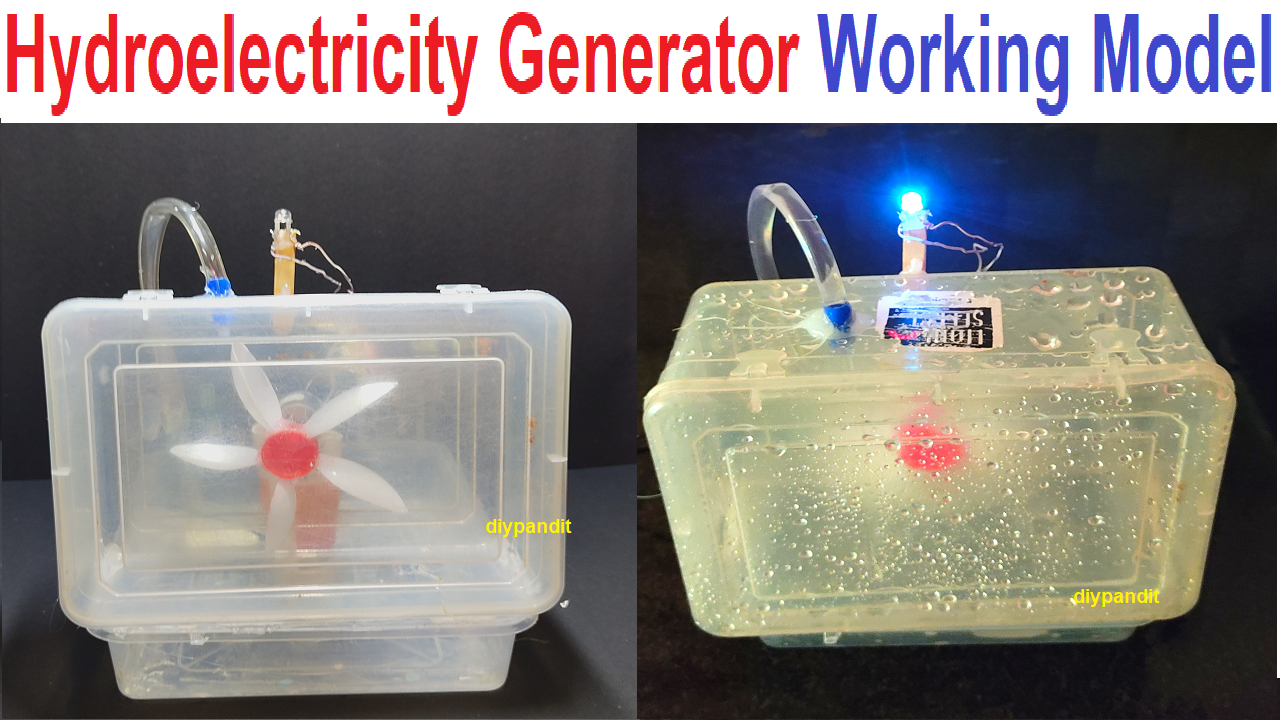A hydroelectric generator, also known as a hydroelectric power plant, works by converting the energy of flowing water into electricity. It harnesses the kinetic energy and potential energy of water in a river or dam to generate electrical power.
Here’s how a hydroelectric generator works:
Creating a working model of a hydroelectric generator using plastic spoons, a transparent plastic box, a spinning wheel, a DC dynamo, a plastic tray, and a DC water pump is a great project idea.

Here’s a step-by-step guide on how to build this model:
Materials You’ll Need:
- Plastic spoons
- Transparent plastic box (to hold spinning wheel)
- Spinning wheel (can be made from cardboard or plastic)
- DC dynamo
- Plastic tray
- DC water pump
- Plastic tubing (for water flow)
- Plastic or wooden supports
- Strong adhesive or glue
- Small water reservoir (bowl or container)
- Water source (tap or pitcher)
Steps to Build the Working Model:
- Prepare the Spinning Wheel:
- Create a spinning wheel by attaching plastic spoons around the edge of a circular piece of cardboard or plastic.
- The spoons will act as the blades of the water wheel.
- Assemble the Transparent Plastic Box:
- Cut an opening in the transparent plastic box to allow the spinning wheel to be partially submerged in water.
- Attach the spinning wheel inside the box so that it can rotate freely.
- Mount the DC Dynamo:
- Attach the DC dynamo securely to the side of the transparent plastic box, near the spinning wheel.
- Ensure that the dynamo’s shaft is aligned with the center of the spinning wheel.
- Attach the Plastic Tray:
- Place the plastic tray at the bottom of the transparent plastic box, under the spinning wheel.
- The tray will catch the water that falls from the spinning wheel.
- Connect the Water Pump:
- Position the DC water pump inside the water reservoir (bowl or container).
- Attach plastic tubing to the water pump’s outlet.
- Position the tubing so that water flows into the spinning wheel’s spoons, causing it to rotate.
- Circulate Water:
- Fill the water reservoir with water.
- Turn on the water pump to start pumping water through the tubing and onto the spinning wheel.
- Generate Electricity:
- As the spinning wheel rotates due to the force of flowing water, it turns the dynamo’s shaft.
- The dynamo generates electricity as it spins.
- Connect Devices:
- Attach wires from the dynamo’s terminals to a small electronic device, such as an LED light.
- When the spinning wheel rotates, it generates electricity, which powers the LED light.
- Test and Observe:
- Turn on the water pump to initiate the rotation of the spinning wheel.
- Observe how the spinning wheel generates electricity and powers the connected device.
This model demonstrates the conversion of kinetic energy from flowing water into mechanical energy (rotational motion of the spinning wheel) and subsequently into electrical energy (generated by the dynamo).
It’s a simplified representation of a hydroelectric generator and serves as an educational tool to understand the basic principles of hydroelectricity generation.
questions asked about hydroelectricity in science fair with answers
Question 1: What is hydroelectricity?
Answer: Hydroelectricity is a form of renewable energy generated by harnessing the energy of flowing water, typically from rivers or dams, to produce electricity.
Question 2: How does a hydroelectric generator work?
Answer: A hydroelectric generator works by using the kinetic and potential energy of flowing water to turn a turbine, which is connected to a generator. As the turbine spins, it converts the energy of the moving water into mechanical energy, which is then transformed into electricity by the generator.
Question 3: What is the role of a dam in hydroelectric power generation?
Answer: A dam is used to create a height difference, or head, between the water source and the turbine. This height difference increases the potential energy of the water, which is then converted into kinetic energy as the water flows through the turbine.
Question 4: What are the environmental benefits of hydroelectric power?
Answer: Hydroelectric power is considered environmentally friendly because it produces no greenhouse gas emissions during operation. It helps reduce reliance on fossil fuels and contributes to cleaner air and lower carbon emissions.
Question 5: Are there any environmental concerns associated with hydroelectricity?
Answer: While hydroelectric power is clean during operation, the construction of dams and reservoirs can have environmental impacts. It can alter natural water flow, affect aquatic habitats, and even displace communities in some cases.
Question 6: How does the amount of electricity generated by a hydroelectric power plant vary with water flow?
Answer: The amount of electricity generated by a hydroelectric power plant is directly proportional to the flow rate of water. Higher water flow rates result in more kinetic energy, which leads to increased turbine rotation and higher electricity generation.
Question 7: What is the relationship between the height of the dam and the energy produced?
Answer: The height of the dam, which creates a greater head of water, contributes to higher potential energy. This potential energy is converted into kinetic energy as the water flows through the turbine, resulting in increased electricity production.
Question 8: Can hydroelectric power provide a consistent energy supply?
Answer: Hydroelectric power can provide a relatively consistent energy supply as long as the water source is reliable. However, it can be affected by seasonal variations in water flow, droughts, and other factors.
Question 9: What is the impact of hydroelectric power on local communities?
Answer: Hydroelectric power projects can have both positive and negative impacts on local communities. While they provide clean energy and jobs, they can also cause displacement, alter ecosystems, and change traditional ways of life.
Question 10: How does hydroelectricity contribute to the overall energy mix?
Answer: Hydroelectric power is a significant contributor to the global energy mix, providing a substantial portion of renewable energy. It complements other renewable sources like solar and wind power to create a more sustainable energy portfolio.

